Synovial Fluid in Knee Osteoarthritis Extends Proinflammatory Niche for Macrophage Polarization
Abstract
1. Introduction
2. Methods
2.1. Cell Lines
2.2. SF Collection
2.3. Immunophenotyping of SF Cells
2.4. In Vitro Cell Differentiation Assay on U937 Cells
2.5. Functional Analysis of the Newly Differentiated Cells in U937 Cell Assay
2.6. Blood Collection for PBMC Isolation
2.7. PBMC Isolation
2.8. Cells Sorting
2.9. In Vitro Cell Differentiation Assay on PBMC-Derived CD14+ Cells
2.10. Functional Analysis of the Newly Differentiated Cells in the Assay on PBMC-Derived CD14+ Cells
2.11. Proteome Analysis of OA SF Samples
2.12. Statistical Analysis
3. Results
3.1. Immunophenotyping of SF-Isolated Cells to Estimate Immune Cell Fractions
3.2. In Vitro Cell Differentiation Assay on U937 Cells
3.3. A Functional Status Analysis of the Newly Differentiated Cells in the Assay on U937 cells
3.4. In Vitro Cell Differentiation Assay on PBMC-Derived CD14+ Cells
3.5. A Functional Status Analysis of the Newly Differentiated Cells in the Assay on PBMC-Derived CD14+ Cells
3.6. M1/M2 Ratio Estimation
3.7. Proteome Analysis of SF Samples
4. Discussion
5. Conclusions
Supplementary Materials
Author Contributions
Funding
Institutional Review Board Statement
Informed Consent Statement
Data Availability Statement
Acknowledgments
Conflicts of Interest
References
- Scazello, C.R.; Plass, A.; Crow, M.K. Innate immune system activation in osteoarthritis: Is osteoarthritis a chronic wound? Curr. Opin. Rheumatol. 2008, 20, 565–572. [Google Scholar] [CrossRef] [PubMed]
- Sokolove, J.; Lepus, C.M. Role of inflammation in the pathogenesis of osteoarthritis: Latest findings and interpretations. Ther. Adv. Musculoskelet. Dis. 2013, 5, 77–94. [Google Scholar] [CrossRef] [PubMed]
- Henrotin, Y.; Lambert, C.; Richette, P. Importance of synovitis in osteoarthritis: Evidence for the use of glycosaminoglycans against synovial inflammation. Semin. Arthritis Rheum. 2014, 43, 579–587. [Google Scholar] [CrossRef] [PubMed]
- Haseeb, A.; Haqqi, T. Immunopathogenesis of osteoarthritis. Clin. Immunol. 2013, 146, 185–196. [Google Scholar] [CrossRef] [PubMed]
- Sreejit, G.; FleEtwood, A.J.; Murphy, A.J.; Nagareddy, P.R. Origin and diversity in health and disease. Clin. Transl. Immunol. 2020, 9, e1222. [Google Scholar] [CrossRef]
- Barboza, E.; Hudson, J.; Chang, W.; Kovats, S.; Towner, R.A.; Silasi-Mansat, R.; Lupu, F.; Kent, C.; Griffin, T.M. Profibrotic infrapatellar fat pad remodeling without M1 macrophage polarization precedes knee osteoarthritis in mice with diet-induced obesity. Arthritis Rheumatol. 2017, 69, 1221–1232. [Google Scholar] [CrossRef]
- Liu, B.; Zhang, M.; Zhao, J.; Zheng, M.; Yang, H. Imbalance of M1/M2 macrophages is linked to severity level of knee osteoarthritis. Exp. Ther. Med. 2018, 16, 5009–5014. [Google Scholar] [CrossRef]
- Xue, Y.Z.; Niu, Y.M.; Tang, B.; Wang, C.M. PCL/EUG scaffolds with tunable stiffness can regulate macrophage secretion behavior. Prog. Biophys. Mol. Biol. 2019, 148, 4–11. [Google Scholar] [CrossRef]
- Koppikar, S.J.; Kulkarni, P.G.; Ingale, D.R.; Shinde, D.; Wagh, N.; Deshpande, S.; Moghe, A.S.; Ranjekar, P.K.; Harsulkar, A.M. Inflammatory response of cultured rat synoviocytes challenged with synovial fluid from osteoarthritis patients correlates with their radiographic grading: A pilot study. In Vitro Cell. Dev. Biol. Anim. 2015, 51, 843–850. [Google Scholar] [CrossRef]
- Ingale, D.; Kulkarni, P.; Electricwala, A.; Moghe, A.; Kamyab, S.; Jagtap, S.; Martson, A.; Koks, S.; Harsulkar, A. Synovium-synovial fluid axis in osteoarthritis pathology: A key regulator of the cartilage degradation process. Genes 2021, 12, 989. [Google Scholar] [CrossRef]
- De Sousa, E.B.; Dos Santos, G.C., Jr.; Aguiar, R.P.; da Costa Sartore, R.; de Oliveira, A.C.L. Osteoarthritic synovial fluid modulates cell phenotype and metabolic behavior in vitro. Stem. Cell. Res. 2019, 2019, 8169172. [Google Scholar]
- Tsai, J.A.; Andersson, M.K.; Ivarsson, M.; Granberg, B.; Stark, A. Effects of synovial fluid from aseptic prosthesis loosening on collagen production in osteoblasts. Int. Orthop. 2009, 33, 873–877. [Google Scholar] [CrossRef] [PubMed][Green Version]
- Nickerson, D.A.; Joshi, R.; Williams, S.; Ross, S.M.; Frank, C. Synovial fluid stimulates the proliferation of rabbit ligament: Fibroblasts in vitro. Clin. Orthop. Relat. Res. 1992, 274, 294–299. [Google Scholar] [CrossRef]
- Kulkarni, P.; Deshpande, S.; Koppikar, S.; Patil, S.; Ingale, D.; Harsulkar, A. Glycosaminoglycan measured from synovial fluid serves as a useful indicator for progression of osteoarthritis and complements Kellgren–Lawrence score. BBA Clin. 2016, 6, 1–4. [Google Scholar] [CrossRef]
- Mundt, L.A.; Shanahan, K. Graff’s Textbook of Routine Urinalysis and Body Fluids; Lippincott Williams & Wilkins: Philadelphia, PA, USA, 2010. [Google Scholar]
- Ingale, D.R.; Kulkarni, P.G.; Koppikar, S.J.; Harsulkar, A.M.; Moghe, A.S. Reduced synovial inflammation and inhibition of matrix metalloproteinases explicates anti-osteoarthritis activity of polyherbal formulations. Indian J. Pharmacol. 2018, 50, 22–29. [Google Scholar] [CrossRef]
- Mets, T.; Kasvandik, S.; Saarma, M.; Maiväli, Ü.; Tenson, T.; Kaldalu, N. Fragmentation of Escherichia coli mRNA by MazF and MqsR. Biochimie 2019, 156, 79–91. [Google Scholar] [CrossRef]
- Cox, J.; Mann, M. MaxQuant enables high peptide identification rates, individualized p.p.b.—Range mass accuracies and proteome-wide protein quantification. Nat. Biotechnol. 2008, 26, 1367–1372. [Google Scholar]
- The Uniprot consortium. Uniprot: The universal protein knowledgebase in 2021. Nucleic. Acids. Res. 2021, 49, D480–D489. [Google Scholar] [CrossRef]
- Cox, J.; Hein, M.Y.; Luber, C.A.; Paron, I.; Nagaraj, N.; Mann, M. Accurate proteome-wide label-free quantification by delayed normalization and maximal peptide ratio extraction, termed MaxLFQ. Mol. Cell. Proteom. 2014, 13, 2513–2526. [Google Scholar] [CrossRef]
- Liu, Q.; Zeng, H.; Yuan, Y.; Wang, Z.; Wu, Z.; Luo, W. Osteopontin inhibits osteoarthritis progression via the OPN/CD44/PI3K signal axis. Genes Dis. 2022, 9, 128–139. [Google Scholar] [CrossRef]
- Wu, Q.; Feng, Q.; Xiong, Y.; Liu, X. RAB31 is targeted by miR-26b and serves the role in the promotion of osteosarcoma. Oncol. Lett. 2020, 20, 244. [Google Scholar] [CrossRef] [PubMed]
- Schmeichel, K.L.; Bissell, M.J. Modeling tissue-specific signaling and organ function in three dimensions. J. Cell Sci. 2003, 116, 2377–2388. [Google Scholar] [CrossRef] [PubMed]
- Hong, D.; Chen, H.-X.; Yu, H.-Q.; Wang, C.; Deng, H.; Lian, Q.-Q.; Ge, R.-S. Quantitative proteomic analysis of dexamethasone-induced effects on osteoblast differentiation, proliferation, and apoptosis in MC3T3-E1 cells using SILAC. Osteoporos. Int. 2011, 22, 2175–2186. [Google Scholar] [CrossRef] [PubMed][Green Version]
- Greening, D.W.; Nguyen, H.P.T.; Elgass, K.; Simpson, R.J.; Salamonsen, L.A. Human endometrial exosomes contain hormone-specific cargo modulating trophoblast adhesive capacity: Insights into endometrial-embryo interactions. Biol. Reprod. 2016, 94, 1–15. [Google Scholar] [CrossRef] [PubMed]
- Jin, L.; Huo, Y.; Zheng, Z.; Jiang, X.; Deng, H.; Chen, Y.; Lian, Q.; Ge, R.; Deng, H. Down regulation of RAS-related Rab-5C dependent endocytosis and glycolysis in cisplatin-resistant ovarian cancer cell lines. Mol. Cell. Proteom. 2014, 13, 3138–3151. [Google Scholar] [CrossRef]
- Macur, K.; Zieschang, S.; Lei, S.; Morsey, B.; Jaquet, S.; Belshan, M.; Fox, H.S.; Ciborowski, P. SWATH-MS and MRM: Quantification of Ras-related proteins in HIV-1 infected and methamphetamine-exposed human monocyte-derived macrophages (hMDM). Proteomics 2021, 15, e2100005. [Google Scholar] [CrossRef]
- Guilliams, M.; Scott, C.L. Does niche competition determine the origin of tissue-resident macrophages? Nat. Rev. Immunol. 2017, 17, 451–460. [Google Scholar] [CrossRef]
- Guilliams, M.; Thierry, G.R.; Bonnardel, J.; Bajenoff, M. Establishment and maintenance of the macrophage niche. Immunity 2020, 52, 434–451. [Google Scholar] [CrossRef]
- Italiani, P.; Boraschi, D. From monocytes to M1/M2 macrophages: Phenotypical vs functional differentiation. Front. Immunol. 2014, 5, 514. [Google Scholar] [CrossRef]
- Van De Laar, L.; Saelens, W.; De Prijck, S.; Martens, L.; Scott, C.L.; Van Isterdael, G.; Hoffmann, E.; Beyaert, R.; Saeys, Y.; Lambrecht, B.N.; et al. Yolk sac macrophages, fetal liver, and adult monocytes can colonize an empty niche and develop into functional tissue-resident macrophages. Immunity 2016, 44, 755–768. [Google Scholar] [CrossRef]
- Kulkarni, P.; Martson, A.; Vidya, R.; Chitnavis, S.; Harsulkar, A. Pathophysiological landscape of osteoarthritis. Adv. Clin. Chem. 2021, 100, 37–90. [Google Scholar] [PubMed]
- Schwende, H.; Fitzke, E.; Ambs, P.; Dieter, P. Differences in the state of differentiation of THP-1 cells induced by phorbol ester and 1,25-dihydroxyvitamin D3. J. Leukoc. Biol. 1996, 59, 555–561. [Google Scholar] [CrossRef] [PubMed]
- García, A.; Serrano, A.; Abril, E.; Jimenez, P.; Real, L.M.; Cantón, J.; Garrido, F.; Ruiz-Cabello, F. Differential effect on U937 cell differentiation by targeting transcriptional factors implicated in tissue- or stage-specific induced integrin expression. Exp. Hematol. 1999, 27, 353–364. [Google Scholar] [CrossRef] [PubMed]
- Liu, H.-Z.; Gong, J.-P.; Wu, C.-X.; Peng, Y.; Li, X.-H.; You, H.-B. The U937 cell line induced to express CD14 protein by 1,25-dihydroxyvitamin D3 and be sensitive to endotoxin stimulation. Hepatobiliary Pancreat. Dis. Int. 2005, 4, 84–89. [Google Scholar]
- Daigneault, M.; Preston, J.A.; Marriott, H.M.; Whyte, M.K.; Dockrell, D.H. The identification of markers of macrophage differentiation in PMA-stimulated THP-1 cells and monocyte-derived macrophages. PLoS ONE 2010, 5, e8668. [Google Scholar] [CrossRef]
- Sintiprungrat, K.; Singhto, N.; Sinchaikul, S.; Chen, S.-T.; Thongboonkerd, V. Alterations in cellular proteome and secretome upon differentiation from monocyte to macrophage by treatment with phorbol myristate acetate: Insights into biological processes. J. Ptroteom. 2010, 73, 602–618. [Google Scholar] [CrossRef]
- Hsueh, M.-F.; Bolognesi, M.P.; Wellman, S.S.; Kraus, V.B. Anti-inflammatory effects of naproxen sodium on human osteoarthritis synovial fluid immune cells. Osteoarthr. Cartil. 2020, 28, 639–645. [Google Scholar] [CrossRef] [PubMed]
- Stout, R.D.; Jiang, C.; Matta, B.; Tietzel, I.; Watkins, S.K.; Suttles, J. Macrophages sequentially change their functional phenotypes in response to changes in microenvironmental influences. J. Immunol. 2005, 175, 342–349. [Google Scholar] [CrossRef]
- Mylonas, K.J.; Nair, M.G.; Prieto-Lafuente, L.; Paape, D.; Allen, J.E. Alternatively activated macrophages elicited by helminth infection can be reprogrammed to enable microbial killing. J. Immunol. 2009, 182, 3084–3094. [Google Scholar] [CrossRef]
- Egawa, M.; Mukai, K.; Yoshikawa, S.; Iki, M.; Mukaida, N.; Kawano, Y.; Minegishi, Y.; Karasuyama, H. Inflammatory monocytes recruited to allergic skin acquire an anti-inflammatory M2 phenotype via basophil-derived interleukin-4. Immunity 2013, 38, 570–580. [Google Scholar] [CrossRef]
- Italiani, P.; Mazza, E.M.C.; Lucchesi, D.; Cifola, I.; Gemelli, C.; Grande, A.; Battaglia, C.; Bicciato, S.; Boraschi, D. Transcriptomic profiling of the development of the inflammatory response in human monocytes in vitro. PLoS ONE 2014, 9, e87680. [Google Scholar] [CrossRef] [PubMed]
- Bastard, J.-P.; Maachi, M.; Lagathu, C.; Kim, M.J.; Caron, M.; Vidal, H.; Capeau, J.; Feve, B. Recent advances in the relationship between obesity, inflammation, and insulin resistance. Eur. Cytokine Netw. 2006, 17, 4–12. [Google Scholar] [PubMed]
- Martín-Fuentes, P.; Civeira, F.; Recalde, D.; García-Otín, A.L.; Jarauta, E.; Marzo, I.; Cenarro, A. Individual variation of scavenger receptor expression in human macrophages with oxidized low-density lipoprotein is associated with a differential inflammatory response. J. Immunol. 2007, 179, 3242–3248. [Google Scholar] [CrossRef]
- Sellam, J.; Berenbaum, F. Is osteoarthritis a metabolic disease? Jt. Bone Spine 2013, 80, 568–573. [Google Scholar] [CrossRef]
- Tootsi, K.; Martson, A.; Kals, J.; Paapstel, K.; Zilmer, M. Metabolic factors and oxidative stress in osteoarthritis. Scand. J. Clin. Lab. 2017, 77, 520–526. [Google Scholar] [CrossRef]
- Castro, B.A.; Flanigan, P.; Jahangiri, A.; Hoffman, D.; Chen, W.; Kuang, R.; De Lay, M.; Yagnik, G.; Wagner, J.R.; Mascharak, S.; et al. Macrophage migration inhibitory factor downregulation: A novel mechanism of resistance to anti-angiogenic therapy. Onchogene 2017, 36, 3749–3759. [Google Scholar] [CrossRef] [PubMed]
- Prescher, N.; Hänsch, S.; Knobbe-Thomsen, C.B.; Stühler, K.; Poschmann, G. Migration behavior of human glioblastoma cells is influenced by the redox-sensitive human macrophage capping protein CAPG. Free Radic. Biol. Med. 2021, 167, 81–93. [Google Scholar] [CrossRef]
- Karimi, N.; Cvjetkovic, A.; Jang, S.C.; Crescitelli, R.; Hosseinpour Feizi, M.A.; Nieuwland, R.; Lötvall, J.; Lässer, C. Detailed analysis of the plasma extracellular vesicle proteome after separation from lipoproteins. Cell. Mol. Life Sci. 2018, 75, 2873–2886. [Google Scholar] [CrossRef]
- Zang, L.; Liu, R.; Luan, Y.; Yao, Y. Tumor necrosis factor-α induced protein 8: Pathophysiology, clinical significance, and regulatory mechanism. Int. J. Biol. Sci. 2018, 14, 398–405. [Google Scholar] [CrossRef]
- Kraus, V.B.; McDaniel, G.; Huebner, J.L.; Stabler, T.V.; Pieper, C.F.; Shipes, S.W.; Petry, N.A.; Low, P.S.; Shen, J.; McNearney, T.A.; et al. Direct in vivo evidence of activated macrophages in human osteoarthritis. Osteoarthr. Cartil. 2016, 24, 1613–1621. [Google Scholar] [CrossRef]
- Fahy, N.; de Vries-van Melle, M.; Lehmann, J.; Wei, W.; Grotenhuis, N.; Farrell, E.; van der Kraan, P.M.; Murphy, J.M.; Bastiaansen-Jenniskens, Y.M.; van Osch, G.J. Human osteoarthritic synovium impacts chondrogenic differentiation of mesenchymal stem cells via macrophage polarisation state. Osteoarthr. Cartil. 2014, 22, 1167–1175. [Google Scholar] [CrossRef] [PubMed]
- Utomo, L.; Bastiaansen-Jenniskens, Y.M.; Verhaar, J.A.; Van Osch, G.J.V.M. Cartilage inflammation and degeneration is enhanced by pro-inflammatory (M1) macrophages in vitro, but not inhibited directly by anti-inflammatory (M2) macrophages. Osteoarthr. Cartil. 2016, 24, 2162–2170. [Google Scholar] [CrossRef] [PubMed]
- Abdelaziz, H.; Balde, O.M.; Citak, M.; Gehrke, T.; Magan, A.; Haasper, C. Kellgren-Lawrence scoring system underestimates cartilage damage when indicating TKA: Preoperative radiograph vs intraoperative photograph. Arch. Orthop. Trauma Surg. 2019, 139, 1287–1292. [Google Scholar] [CrossRef] [PubMed]
- Kriegova, E.; Manukyan, G.; Mikulkova, Z.; Gabcova, G.; Kudelka, M.; Gajdos, P.; Gallo, J. Gender-related differences observed among immune cells in synovial fluid in knee osteoarthritis. Osteoarthr. Cartil. 2018, 26, 1247–1256. [Google Scholar] [CrossRef] [PubMed]
- Gomez-Aristizabal, A.; Gandhi, R.; Mahomed, N.N.; Marshall, K.W.; Viswanathan, S. Synovial fluid monocyte/macrophage subsets and their correlation to patient-reported outcomes in osteoarthritic patients: A cohort study. Arthritis Res. Ther. 2019, 21, 26. [Google Scholar] [CrossRef]
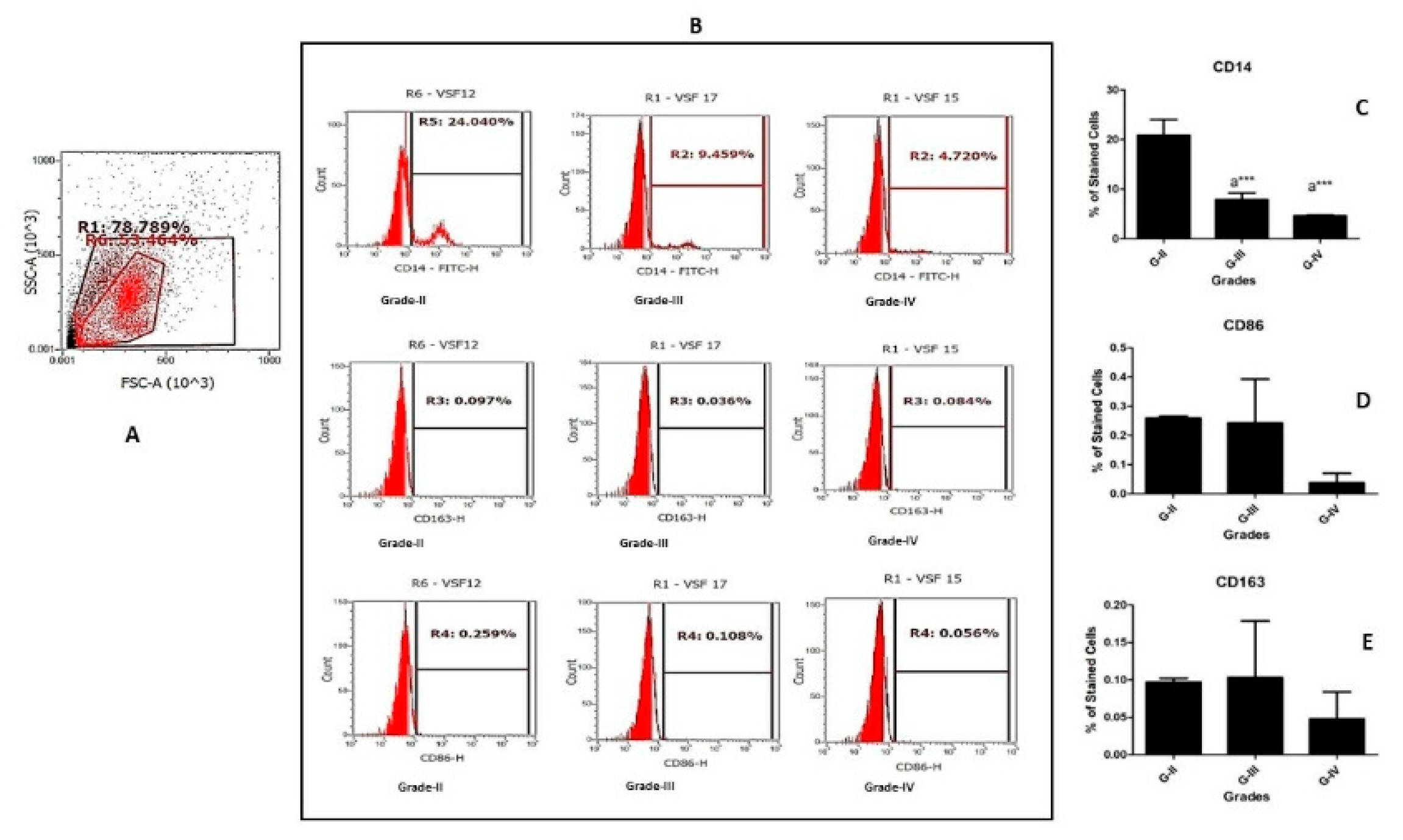

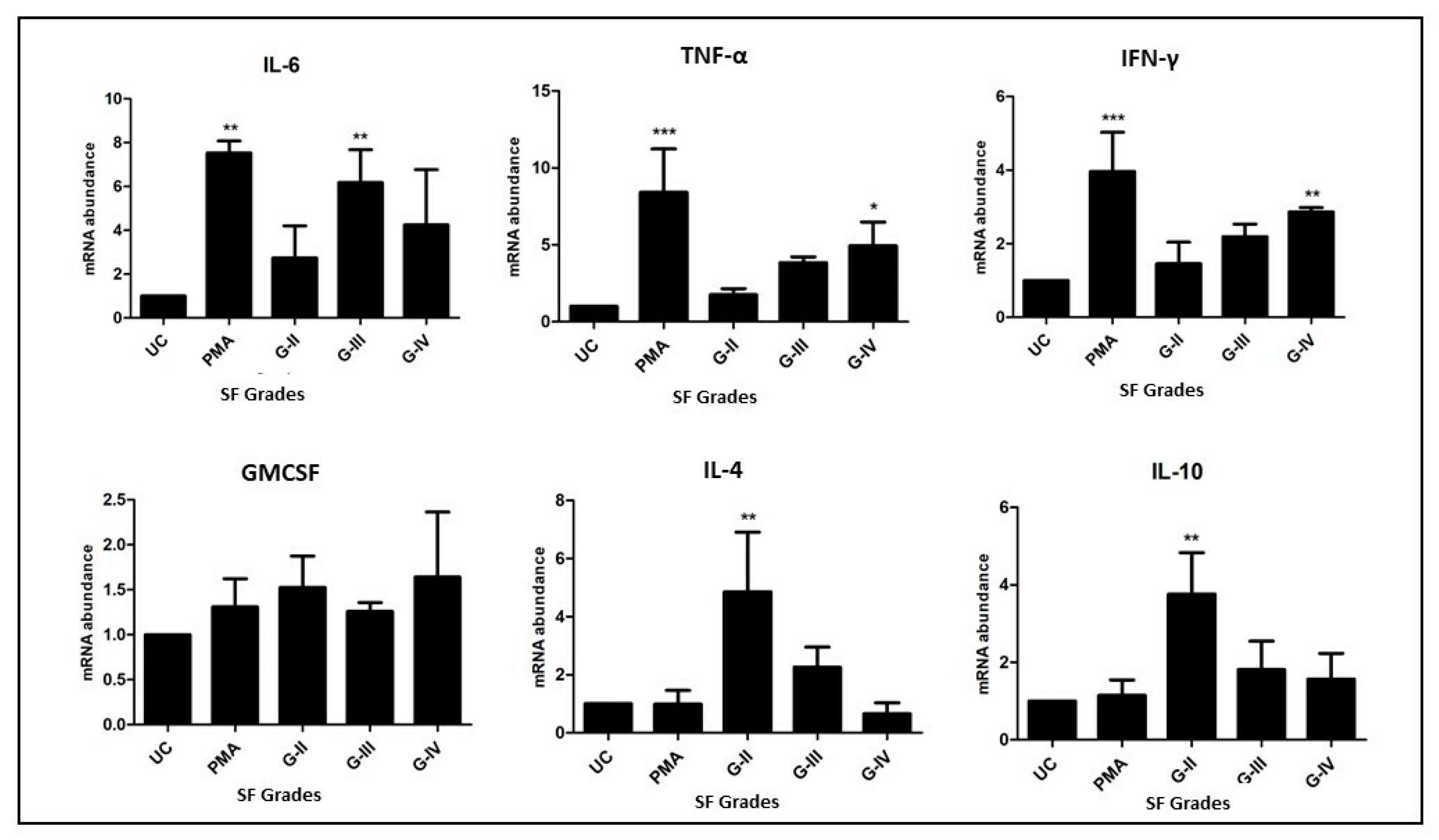
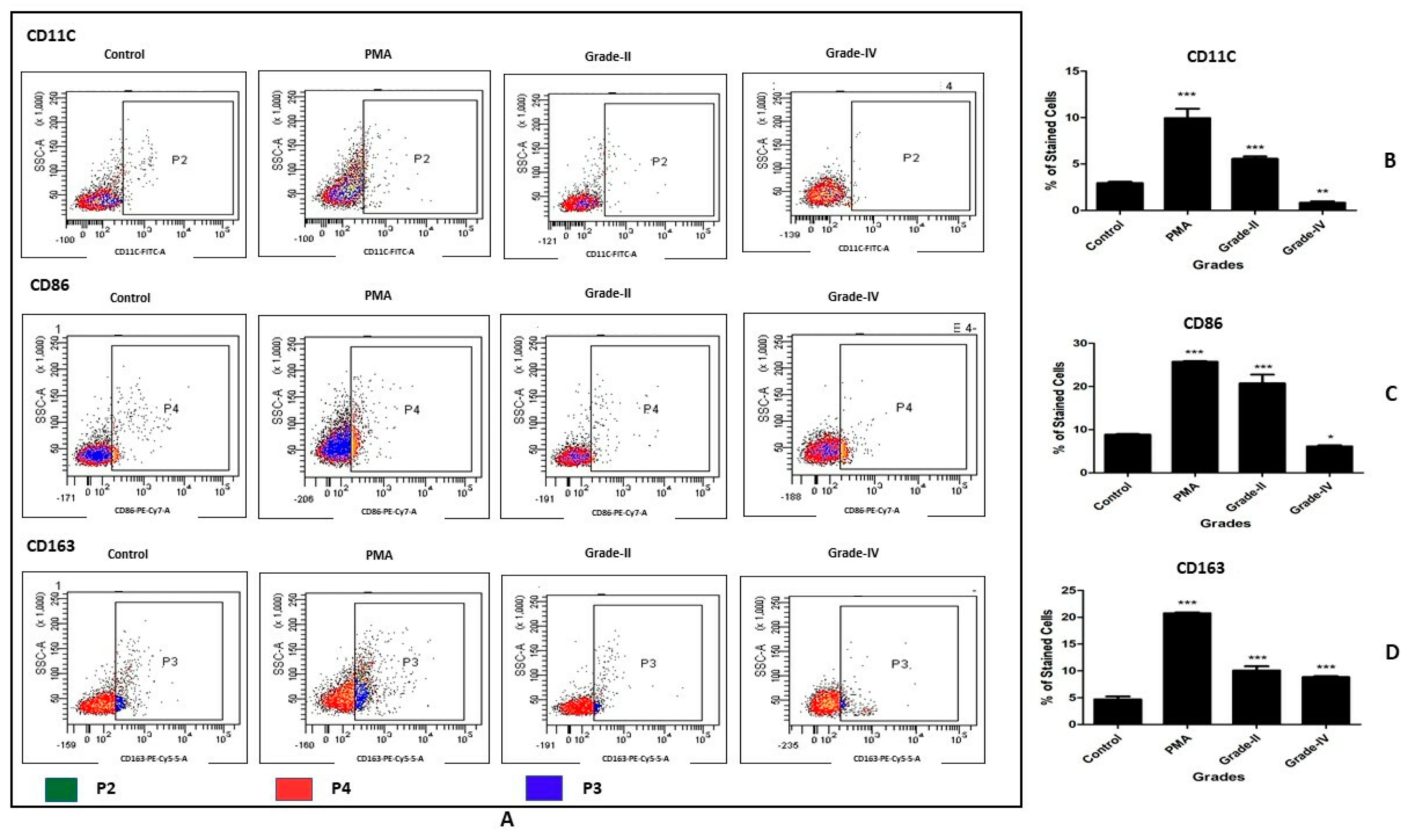
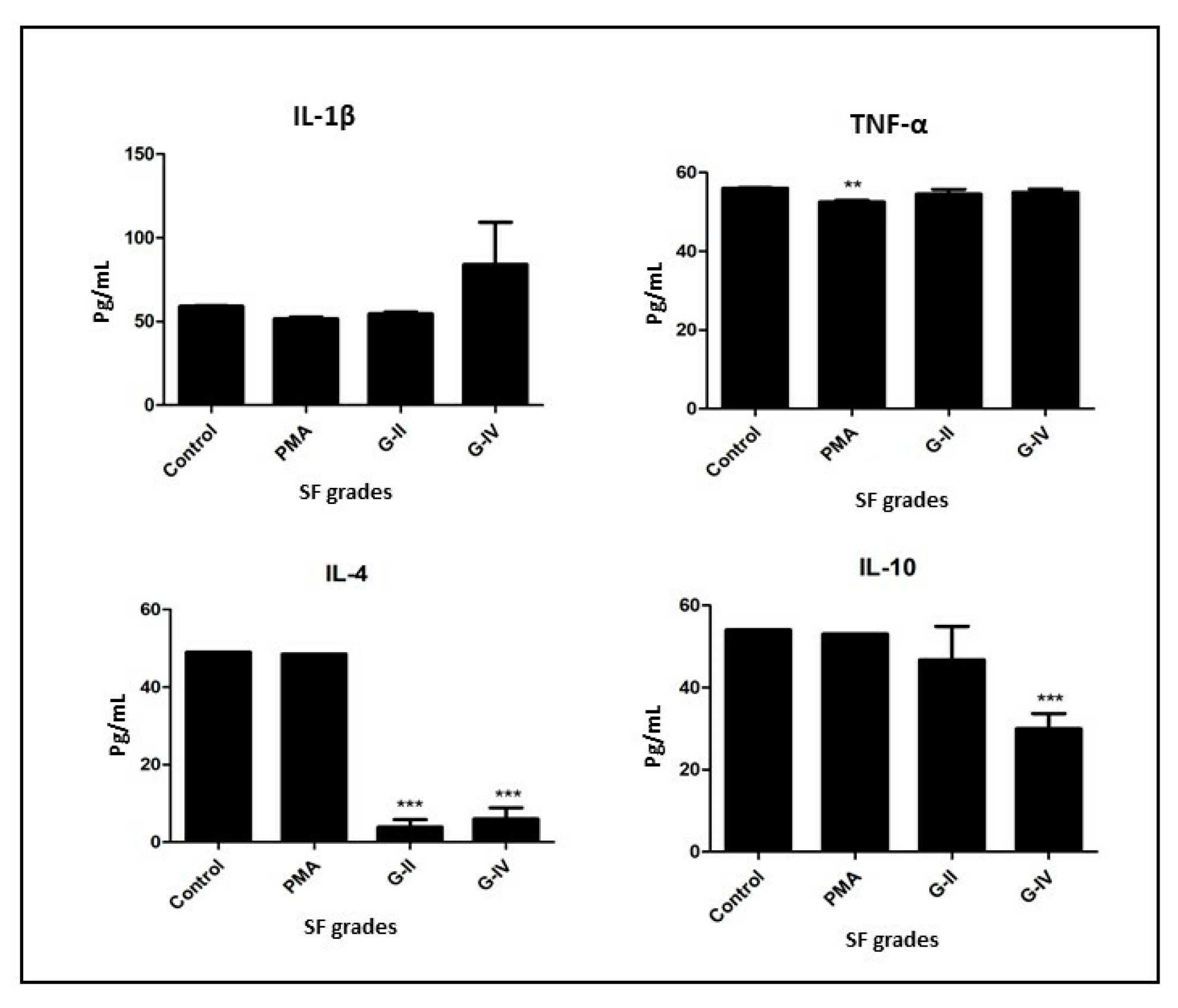
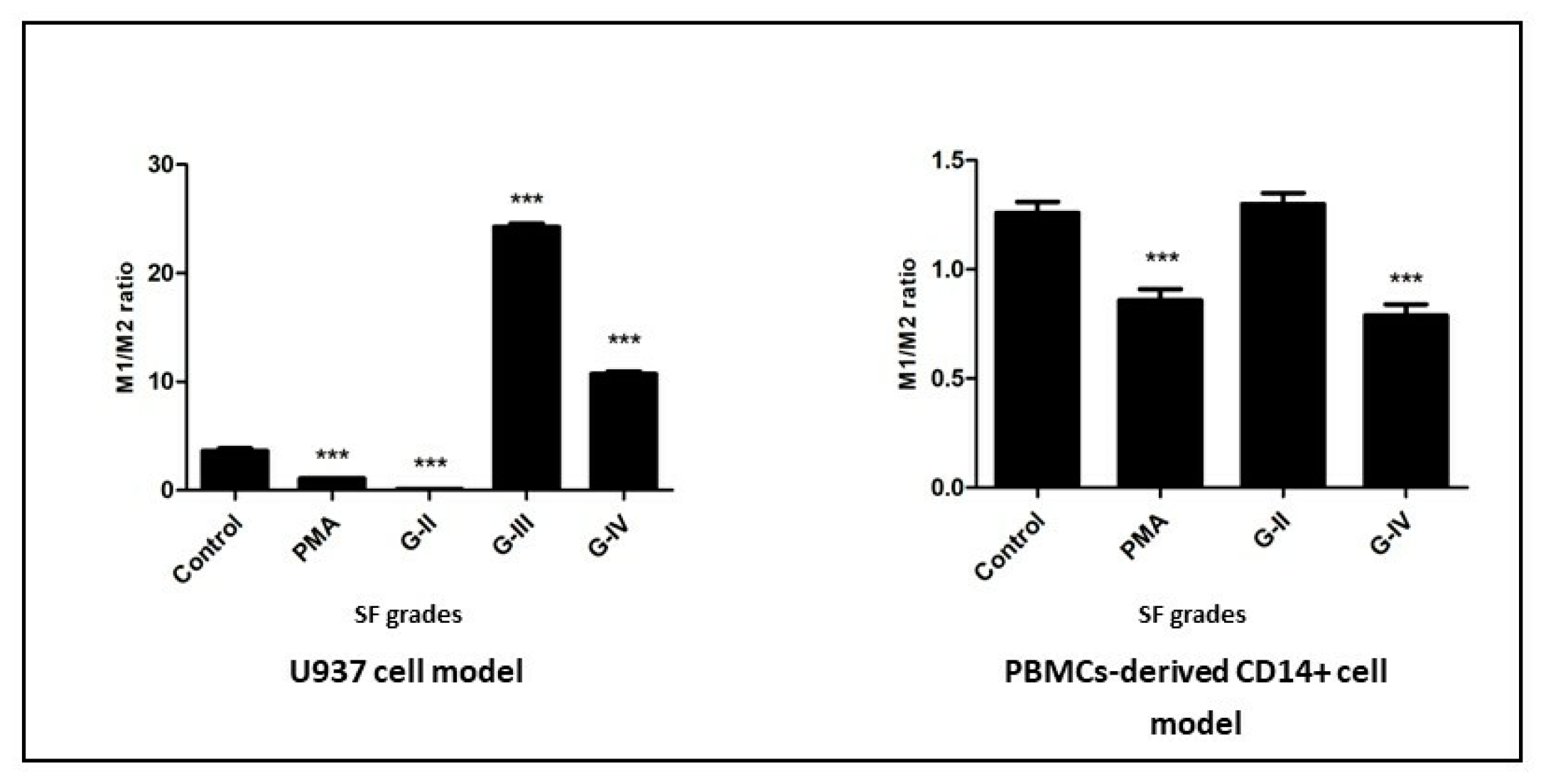
| No. | Protein | Action | Fold Change | ||
|---|---|---|---|---|---|
| G1-G2 | G1-G3 | G1-G4 | |||
| 1 | Macrophage migration inhibitory factor (MIF) | Prevent random migration and stimulate population growth of macrophages | −0.295 | −0.935 | −38.678 |
| 2 | Macrophage-capping protein, (CAPG/MCP) | Regulate cell migration through actin fiber modulation | 0 | 38.623 | 41.396 |
| 3 | Matrix metalloproteinase-9, (MMP9) | Multiple roles, including activation of macrophages | 0 | 40.987 | 41.693 |
| 4 | Prostaglandin E synthase 3, (PTGES3) | Regulate release of inflammatory prostaglandin by macrophages | 37.965 | 37.109 | 0 |
| 5 | Osteopontin C | Osteopontin affects macrophage polarization, promoting endocytic but not inflammation [21] | 0 | 0 | 35.955 |
| 6 | Grancalcin (GCA) | Control calcium influx and modulate secondary signaling | 0 | 42.935 | 41.813 |
| 7 | Tumor necrosis factor α-induced protein 8 (TNFAIP8) | Inflammatory response and immune homeostasis | 0 | 35.575 | 38.093 |
| 8 | Ras-related protein Rab-1A, RAB1A | Plays a role in cell adhesion and cell migration | 0 | 40.627 | 39.556 |
| 9 | Ras-related protein Rab-7a, RAB7A | Enables Phagocytosis | 37.220 | 39.440 | 38.900 |
| 10 | Ras-related protein Rab-10 RAB10 | Phagosome maturation | 0 | 38.686 | 38.171 |
| 11 | Ras-related protein Rab-8B (RAB8B) | Antigen processing and presentation | 1 | 39.618 | 37.869 |
| 12 | Ras-related protein Rab-31 (RAB31) | Serves essential roles in vesicle and granule targeting [22] | 0 | 37.347 | 37.264 |
| 13 | Ras-related protein Rab-14 (RAB14) | Rab14 found to play a crucial role in phagocytosis, homotypic phagosome, and lysosome fusion [23] | 0 | 37.731 | 37.122 |
| 14 | Ras-related protein Rab-2A (RAB2A) | Ras-related GTP-binding proteins involved in the regulation of secretion [24] | 0 | 39.676 | 36.786 |
| 15 | Ras-related protein Rab-1B (RAB1B) | Regulates vesicular transport between the endoplasmic reticulum and successive Golgi compartments | 0 | 35.756 | 35.921 |
| 16 | Ras-related protein Rab-3D (RAB3D) | Involved in regulated exocytosis [25] | 0 | 38.255 | 35.236 |
| 17 | Ras-related protein Rab-5C (RAB5C) | Endocytosis [26] | 36.733 | 38.253 | 35.156 |
| 18 | Ras-related protein Rab-21 (RAB21) | Regulates integrin internalization and recycling; may regulate cell adhesion and migration [27] | 0 | 39.135 | 0 |
Publisher’s Note: MDPI stays neutral with regard to jurisdictional claims in published maps and institutional affiliations. |
© 2022 by the authors. Licensee MDPI, Basel, Switzerland. This article is an open access article distributed under the terms and conditions of the Creative Commons Attribution (CC BY) license (https://creativecommons.org/licenses/by/4.0/).
Share and Cite
Kulkarni, P.; Srivastava, V.; Tootsi, K.; Electricwala, A.; Kharat, A.; Bhonde, R.; Koks, S.; Martson, A.; Harsulkar, A. Synovial Fluid in Knee Osteoarthritis Extends Proinflammatory Niche for Macrophage Polarization. Cells 2022, 11, 4115. https://doi.org/10.3390/cells11244115
Kulkarni P, Srivastava V, Tootsi K, Electricwala A, Kharat A, Bhonde R, Koks S, Martson A, Harsulkar A. Synovial Fluid in Knee Osteoarthritis Extends Proinflammatory Niche for Macrophage Polarization. Cells. 2022; 11(24):4115. https://doi.org/10.3390/cells11244115
Chicago/Turabian StyleKulkarni, Priya, Vanshika Srivastava, Kaspar Tootsi, Ali Electricwala, Avinash Kharat, Ramesh Bhonde, Sulev Koks, Aare Martson, and Abhay Harsulkar. 2022. "Synovial Fluid in Knee Osteoarthritis Extends Proinflammatory Niche for Macrophage Polarization" Cells 11, no. 24: 4115. https://doi.org/10.3390/cells11244115
APA StyleKulkarni, P., Srivastava, V., Tootsi, K., Electricwala, A., Kharat, A., Bhonde, R., Koks, S., Martson, A., & Harsulkar, A. (2022). Synovial Fluid in Knee Osteoarthritis Extends Proinflammatory Niche for Macrophage Polarization. Cells, 11(24), 4115. https://doi.org/10.3390/cells11244115







